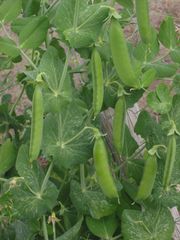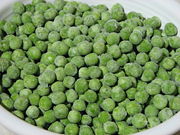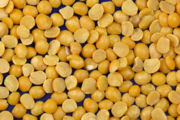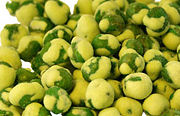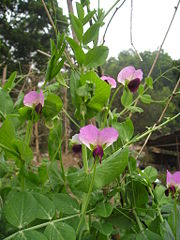Pea
2008/9 Schools Wikipedia Selection. Related subjects: Food; Plants
| Pea | ||||||||||||||||||
|---|---|---|---|---|---|---|---|---|---|---|---|---|---|---|---|---|---|---|
 Peas are contained within a pod
|
||||||||||||||||||
| Scientific classification | ||||||||||||||||||
|
||||||||||||||||||
| Binomial name | ||||||||||||||||||
| Pisum sativum L. |
A pea, although treated as a vegetable in cooking, is botanically a fruit; the term is most commonly used to describe the small spherical seeds or the pods of the legume Pisum sativum. The name is also used to describe other edible seeds from the Fabaceae like the pigeon pea (Cajanus cajan), the cowpea (Vigna unguiculata), and the seeds from several species of Lathyrus.
P. sativum is an annual plant, with a lifecycle of one year. It is a cool season crop grown in many parts of the world; planting can take place from winter through to early summer depending on location. The average pea weighs between 0.1 and 0.36 grams. The species is used as a fresh vegetable, frozen or canned, but is also grown to produce dry peas like the split pea. These varieties are typically called field peas.
P. sativum has been cultivated for thousands of years. The sites of cultivation have been described in southern Syria and southeastern Turkey, and some argue that the cultivation of peas with wheat and barley seems to be associated with the spread of Neolithic agriculture into Europe.
Description
| Raw Green Pea Nutritional value per 100 g (3.5 oz) |
||||||||||||||||||||||||||||||||||||||
|---|---|---|---|---|---|---|---|---|---|---|---|---|---|---|---|---|---|---|---|---|---|---|---|---|---|---|---|---|---|---|---|---|---|---|---|---|---|---|
| Energy 80 kcal 340 kJ | ||||||||||||||||||||||||||||||||||||||
|
||||||||||||||||||||||||||||||||||||||
| Percentages are relative to US recommendations for adults. Source: USDA Nutrient database |
||||||||||||||||||||||||||||||||||||||
The pea is a green, pod-shaped fruit, widely grown as a cool-season vegetable crop. The seeds may be planted as soon as the soil temperature reaches 10°C, with the plants growing best at temperatures of 13°C to 18°C. They do not thrive in the summer heat of warmer temperate and lowland tropical climates but do grow well in cooler high altitude tropical areas. Many cultivars reach maturity about 60 days after planting. Generally, peas are to be grown outdoors during the winter, not in greenhouses. Peas grow best in slightly acidic, well-drained soils.
Peas have both low-growing and vining cultivars. The vining cultivars grow thin tendrils from leaves that coil around any available support and can climb to be 1-2 m high. A traditional approach to supporting climbing peas is to thrust branches pruned from trees or other woody plants upright into the soil, providing a lattice for the peas to climb. Branches used in this fashion are called pea brush. Metal fences, twine, or netting supported by a frame are used for the same purpose. In dense plantings, peas give each other some measure of mutual support. Pea plants do not need pollination from other plants as they have special properties that allow them to pollinate themselves and make more genetic copies. This is the reason Gregor Mendel experimented on these fascinating plants.
Varieties
Many varieties of P. sativum have been bred. Widely cultivated variations include:
- Pisum sativum var. macrocarpon is commonly known as the snow pea
- Pisum sativum var. macrocarpon ser. cv. is known as the sugar or snap pea or mange-tout
Both of these are eaten whole before the pod reaches maturity. The snow pea (often erroneously called "mange tout") pod is eaten flat. In sugar snap peas, the pod becomes cylindrical but is eaten before the seeds inside develop while the pod is still crisp, hence the 'snap' term used.
Diseases
Culinary use
In early times peas were grown mostly for their dry seeds. In modern times however peas are usually boiled or steamed which breaks down the cell walls and makes the taste sweeter and the nutrients more bio-available. Along with broad beans and lentils, these formed an important part of the diet of most people in Europe during the Middle Ages (Bianchini 1975 p 40). By the 1600s and 1700s it had became popular to eat peas "green", that is, while they are immature and right after they are picked. This was especially true in France and England, where the eating of green peas was said to be "both a fashion and a madness" (OSU 2006). New cultivars of peas were developed by the English during this time which became known as garden peas and English peas. The popularity of green peas spread to North America. Thomas Jefferson grew more than 30 cultivars of peas on his estate (Kafka 2005 p 297). With the invention of canning and freezing of foods, green peas became available year-round, and not just in the spring as before.
Fresh peas are often eaten boiled and flavored with butter and/or spearmint as a side dish vegetable. Salt and pepper are also commonly added to peas when served. Fresh peas are also used in pot pies, salads and casseroles. Pod peas (particularly sweet cultivars called mange tout and sugar peas, or the flatter "snow peas," called hé lán dòu, 荷 兰 豆 in Chinese) are used in stir-fried dishes, particularly those in American Chinese cuisine. Pea pods do not keep well once picked, and if not used quickly are best preserved by drying, canning or freezing within a few hours of harvest.
In India, fresh peas are used in various dishes such as aloo matar (curried potatoes with peas) or matar paneer ( paneer cheese with peas), though they can be substituted with frozen peas as well. Peas are also eaten raw as they are sweet when fresh off the bush.
Dried peas are often made into a soup or simply eaten on their own. In Japan, China, Taiwan and some South-east Asian countries, including Thailand and Malaysia, the peas are roasted and salted, and eaten as snacks. In the UK, dried yellow split peas are used to make pease pudding (or "pease porridge"), a traditional dish. In North America a similarly traditional dish is split pea soup.
Ärtsoppa is a traditional Scandinavian food which predates the Viking era. This food was made from a fast-growing pea that would mature in a short growing season. Ärtsoppa was especially popular among the many poor who traditionally only had one pot and everything was cooked together for a dinner using a tripod to hold the pot over the fire. When pork was available it was known as Ärtsoppa och fläsk and this tradition has continued to the present day. After the Christian conversion this soup was served on Thursday evening because Friday was a fasting day.
In Chinese cuisine, pea sprouts (豆苗; dòu miáo) are commonly used in stir-fries and its price is relatively high due to its agreeable taste. Pea leaves are often considered a delicacy as well.
In Greece, Turkey, Cyprus, and other parts of the Mediterranean, peas are made into a stew with meat and potatoes. In Greek this stew is called arakas, whilst in Cyprus and Turkey it is called mpizeli or mpizelia.
In the United Kingdom, dried, rehydrated and mashed marrowfat peas, known by the public as mushy peas, are popular, originally in the north of England but now ubiquitously, and especially as an accompaniment to fish and chips or meat pies, particularly in fish and chip shops. Sodium bicarbonate is sometimes added to soften the peas. In 2005, a poll of 2,000 people revealed the pea to be Britain's 7th favorite culinary vegetable. Processed peas are mature peas which have been dried, soaked and then heat treated (processed) to prevent spoilage — in the same manner as pasteurising.
Cooked peas are sometimes sold dried and coated with wasabi as a spicy snack.
Some forms of etiquette require that peas be only eaten with a fork and not pushed onto the fork with a knife .
Peas in science
In the mid-1800s, Gregor Mendel's observations of pea pods led to the principles of Mendelian genetics, the foundation of modern genetics.
Etymology
According to etymologists, the term was taken from the Latin pisum and adopted into English as the noun pease (plural peasen), as in pease pudding. However, by analogy with other plurals ending in -s, speakers began construing pease as a plural and constructing the singular form by dropping the "s", giving the term "pea". This process is known as back-formation.
The name marrowfat pea for mature dried peas is recorded by the OED as early as 1733. The fact that an export cultivar popular in Japan is called Maro has led some people to assume mistakenly that the English name marrowfat is derived from Japanese.
